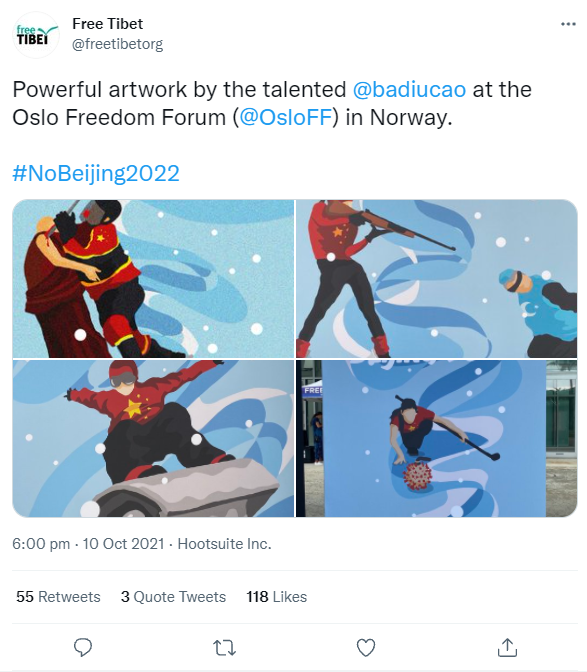Activists are ramping up efforts to shine a light on China’s human rights abuses ahead of the Beijing Winter Olympic Games and they’re using art (plus hahstags) to get their message across.
The #NoBeijing2022 campaign is calling on governments and sponsors to boycott the Beijing 2022 Olympics (due to take place in February), arguing that supporting the event means tactic approval for China’s “reprehensible human rights abuses”.
Groups representing Tibetans, Uyghurs and Hongkongers, and Chinese activists, among others, are organising under the #NoBeijing2022 banner. Their goal is to encourage international action against rights abuses, such as the “mass internment and torture” of Uyghur Muslims in Xinjiang, described as a “dystopian hellscape” by Amnesty International.
Critics of hashtag activism have dubbed it “slacktivism”, arguing that tweeting in support of a cause does little to contribute to “real world” change. However, those who dismiss online activism may be underestimating the “subtlety and power of how messages and beliefs move through the modern digital ecosystem” (in the words of Deen Freelon, associate professor at the University of North Carolina).
Given that China is not allowing foreign spectators to attend Beijing 2022 (ostensibly because of coronavirus restrictions), the kind of digital protest being undertaken as part of #NoBeijing2022 may be the best chance activists have to get their voice heard.
In addition, many of those speaking out under #NoBeijing2022 are utilising a mix of both hashtag activism and art for social change. With this approach, art (offline) acts as a more traditional and tangible form of communication. The messages are then amplified and spread far and wide through the use of social media platforms (online). Could this be the perfect mix of the two mediums?
On October 10, for example, the NGO Free Tibet shared images of anti-Olympics artwork by Chinese-Australian artist Badiucao at the Oslo Freedom Forum in Norway: lifting the work from a physical exhibition to global audiences following #NoBeijing2022 (see below.)

Badiucao himself believes that art combined with the internet has power to “deconstruct the arrogance and authority of dictatorship”. He also describes his art as a record of his personal perspective on social issues, which exists “to confront the official record”. In this sense his Twitter account is much more than hashtag activism, but also a digital journal, a contribution to history, a means of challenging power structures.
Also earlier this month, German activists put on a #NoBeijing2022 light-show at the Chinese consulate in Munich, seen in this YouTube video. (Munich has one of the world’s largest exile communities of Uyghurs.)
Light projection as a form of art and means to protest can be seen as one way to democratise access to protected visual spaces. In Munich, the (online) sharing of this (offline) projective activism adds another dimension, empowering the artists behind the work, magnifying their challenge to authority, and permitting the message to cross country borders.
Detractors say that light projection constitutes a new form of property trespass, but it’s certainly more peaceful than other protests seen at the same consulate in the run up to the Beijing 2008 Olympic Games.

According to the Associated Press, International Olympic Committee (IOC) President Thomas Bach has repeatedly dodged questions about the propriety of holding the 2022 winter games in China despite evidence of alleged genocide, vast surveillance, and crimes against humanity.
While the IOC has remained tight-lipped on the matter, the hashtag #NoBeijing2022 and the artworks connected to it are keeping the conversation going.
What do you think about #NoBeijing2022? Can this kind of campaign drive meaningful social change? And what constitutes “meaningful” change to you? I look forward to hearing your thoughts, dear reader.
And in case you’re interested. Who am I?
- A journalist-turned comms professional
- A student on Malmö University’s Communication for Development MA
- One member of the five-strong team of women behind this blog: New Media, New World.
Thank you for being here : )
